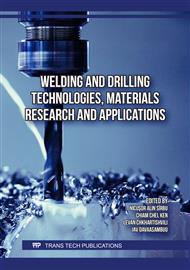p.3
p.17
p.23
p.31
p.41
p.49
p.59
p.73
p.91
Connection between the Matching Phenomenon and Fatigue Crack Growth Behaviour of High Strength Structural Steel Welded Joints
Abstract:
The application of high strength structural steels in welded structures is growing steadily and intensively. Quenched and tempered (Q+T) as well as thermomechanically treated (TM) steel base materials are developing faster than the filler metals for fusion welding processes, and therefore the selection of filler metal deserves special attention. Welded structures made of high strength steel are often subjected to cyclic loading, which can cause initiation and propagation of fatigue cracks and can lead to fatigue fracture failure of the structural element or the structure. This characteristic must also be taken into account when selecting the filler metal. In order to study this issue, welded joints were made from base materials in the 700-1300 MPa strength category using gas metal arc welding (GMAW) process. The applied filler metals were of the undermatching, matching or overmatching type, depending on the strength of the base material. Fatigue crack propagation (FCP) tests were performed on specimens machined from the welded joints, in which notch locations and crack propagation directions were statistical in nature. Therefore, the fatigue crack propagation directions were parallel and perpendicular to the longitudinal axis of the welded joints and located in different zones of the heat affected zone (HAZ). From these investigations, the two parameters (C and n) of the Paris-Erdogan equation were determined for each specimen and statistical samples were formed from the base material-filler metal matching pairs. During the evaluation of the results, it was found that the matching phenomenon has significant effect on the fatigue crack propagation behavior of the welded joints and that this effect depends on the strength category of the base material. Based on these results, recommendations for the applicable base material-filler metal pairings were proposed.
Info:
Periodical:
Pages:
41-48
Citation:
Online since:
November 2025
Authors:
Price:
Сopyright:
© 2025 Trans Tech Publications Ltd. All Rights Reserved
Share:
Citation:


